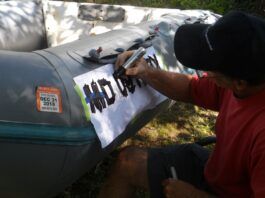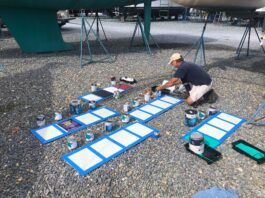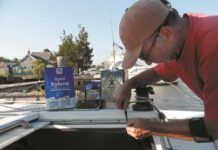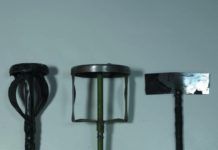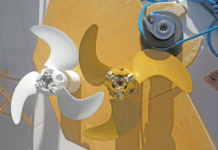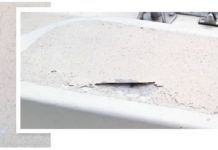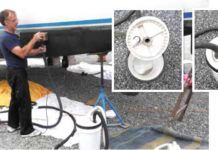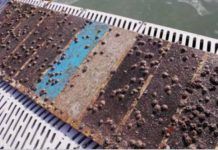Making Sense of Solvents
Practical Sailor wades into the world of thinners and clean-up chemicals.
Not All Paint Mixers are Created Equal
If you buy your paint in summer or fall, you can often save some money, but this means youll need to mix it well prior to painting. In fact most of the paint in the store has settled long enough to have separated, leaving a thin solvent-rich layer on the top and 2/3 of the paint as a sludge on the bottom. Intended for less stubborn house paint, ordinary mixers clog up with the goo, taking 15 minutes or more to properly rejuvenate a can. After a dozen layers of paint build up, they scarcely mix at all.
Freshwater Bottom Paint Test
We werent too surprised to learn that Irgarol 1051, an antifouling paint additive that last year was awaiting U.S. Environmental Protection Administration certification, has received approval to re-enter the market. As we reported last spring (see Bottom Paint Update 2017, Practical Sailor April 2017), Irgarol 1051s manufacturer, BASF, had moved its manufacturing to Asia, and was waiting for its new foreign-sourced formula to be certified by the EPA. By 2016, nearly all of the major antifouling paint manufacturers in the U.S. had exhausted their reserves. Now Irgarol is back, which means there may be some confusion as to what secret sauce is boosting the performance of your top-shelf slime-resistant paint.
Cleaning Your Hull
Before diving into a hull cleaning project, check first what the rules are in your marina. Marinas are regulated under the Clean Water Act and they often have their own policies regarding DIY hull-cleaning.
What About GlowFast Tethers?
In response to your request regarding safety tether knowledge or suggestions (see Safety Tether Warning, Inside Practical Sailor) please test and include information about Glowfasts HLR Safety Line system.
Which Bottom Paint for a Watertender?
I have a West Marine Watertender 9.4 with a polyethylene hull (versus polypropylene for the Walker Bays) and am wondering if there is an anti-fouling paint that is suitable. Looking through the product info for both, the manufacturers both claim that the plastics are slippery enough to not need paint, however, the plastic wrap (unknown material) on the wooden pilings on my own docks in Florida have marine growth on them, so I suspect the same will happen with my Watertender (currently stored on the dock).There are conflicting reports/opinions on various forums as to if there is a paint that would actually stick to the hull, as well as potentially damage the plastic.
Propeller Paints that Last
A cheap, effective antifouling paint for a propeller is as rare as a good pun. The coating must not only ward off all marine growth, it must present a smooth slick surface that can stand up to the constant water friction when the boat is under power. And in the case of a folding prop, the coating must also adhere in nooks and crannies and, in some cases, even withstand metal-to-metal contact. These demands are well beyond the reach of any run-of-the-mill marine coating. Thus, our search for-wait for it-a prop(er) paint.
Durabak Nonskid Coating Long-term Test Update
In the January 2012 issue, we evaluated the application ease and traction performance of do-it-yourself nonskid options. A few months prior to the report, a Practical Sailor tester applied the tests Best Choice pick, Durabak, to the coachroof of his Chesapeake Bay-based 1978 Union 36; this served as a real-world test of the coating systems application ease and coating longevity. That field test has reached the five-year mark, so we wanted to offer an update on the coatings long-term performance.
Dustless Sanding
Responsible boatyard work requires dust collection. Whether its toxic bottom paint or ordinary sanding dust, it still makes a mess and can ruin a neighbors paint job-in-progress. Dustless sanders have hose connections leading to vacuum cleaners, but unless it is a sophisticated vacuum with multi-stage dust separation, those filters clog and dust flies.
Bottom Paint Checkup 2016
A fairly significant change has taken place in the world of antifouling paint for recreational boaters in the United States. Last year, multi-national chemical company BASF decided it would not renew its U.S. license for the pesticide Irgarol. A common additive to copper-based paints, Irgarol helps prevent the growth of algae and other soft growth. Our tests have shown that although Irgarol doesn't lengthen the duration of antifouling protection, it can noticeably help prevent slime growth during the first few months after immersion. As a result of BASFs decision, most manufacturers have a limited supply of Irgarol paints and have been phasing out products that contain it. Paints containing Irgarol are still on store shelves, but these inventories are expected to run out as early as this spring.



































